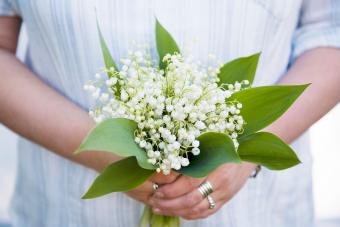
April showers bring May flowers, and two of these are the birth flowers for people born in spring's sweetest month. The aromatic lily-of-the-valley is not just May's birth flower but also a mainstay in perfumes, while hawthorn is actually a tree sometimes called the May tree. These pretty flowers are both super fragrant and part of what gives the month of May its characteristic springy smell. Here's what else you need to know about May's birth flowers.
Lily-of-the-Valley Flowers Look Like Little Bells
 Lily-of-the-valley flowers are some of the sweetest looking around. These pure white blossoms look like little bells drooping from a common, arched stem. They're perennials, and they do best in partial shade.
Lily-of-the-valley flowers are some of the sweetest looking around. These pure white blossoms look like little bells drooping from a common, arched stem. They're perennials, and they do best in partial shade.
Lily-of-the-Valley Is a Big Deal in the Perfume World
Known in French as le muguet, lily-of-the-valley might smell familiar, because it's commonly used in perfumes. Its unmistakable aroma is the top note in a number of fragrances from famous design houses such as Dior, Kate Spade, and Yves Saint Laurent.
Have someone with a May birthday on your list? They'll love a muget-based fragrance as a gift! It's a clever way to work in their birth flower.
Like Springtime Itself, Lily-of-the-Valley Symbolizes Rebirth
Along with its fragrance, lily-of-the-valley has associated symbolism that makes it an especially meaningful gift for May birthdays. It's a symbol of rebirth, much like the entire season in which the flower blossoms. It can also represent purity, humility, and motherhood (Mother's Day gift, anyone?).
Related: Lily-of-the-Valley Gardening Guide
In Ancient Times, People Believed Lily-of-the-Valley Protected Against Evil Spirits
Ancient folklore holds lily-of-the-valley in high esteem. It's believed that once planted in your garden, lily-of-the-valley will protect against evil spirits coming into your garden and into your home.
Lily-of-the-Valley Is Poisonous
You should keep children and pets away from lily-of-the-valley. This sweet-smelling flower looks delicate and smells like a dream, but the plant is highly poisonous.
Hawthorn Trees Are Members of the Rose Family

The hawthorn (Crataegus monogyna) isn't a cut flower — it's a blooming small tree that is part of the rose family. The hawthorn can be trained to grow as a shrub, specifically as a blooming hedge. This tree is also known as the May tree. The blooms are pink, red, and white.
Some Hawthorns Have a Sharp Surprise
Some hawthorns have sharp thorns that conceal several pathogenic bacteria as part of their defense arsenal.
Hawthorns Have a Very Distinctive Aroma
Once you've smelled a hawthorn blossom, you'll always be able to pick it out. It's a spicy fragrance that some people enjoy, and others aren't too fond of. The blossoms smell of almonds and spice with an underlying musky odor that some people find unpleasant. Still, in balance, hawthorn is used in perfumes, lending its distinctive odor to fragrances like Burberry's Hawthorn Bloom perfume.
The Trees Produce Edible Fruit
Hawthorn blossoms give way to fruits called haws, which are used to make jams, jellies, and flavoring for brandy, wines, and syrups.
Hawthorn Is a Symbol of Fertility
Hawthorn blooms (perhaps because of their musky aroma) have long been associated with pagan rites of fertility and sexual abandon. They're also symbols of happiness, hope, faith, and love.
Hawthorn Is Closely Associated With May Day
Hawthorn plays an important role in the Celtic holiday Beltane, festival of spring, also known as May Day. The blossoms are used to decorate to celebrate this time of renewal and awakening.
Fall in Love With May Birth Flowers
The mystique and history behind the lily-of-the-valley and hawthorn blossoms align with many of the symbolic meanings associated with the month in which they bloom, May. These vibrant flowers are bursting with spring energy and aroma, making them ideal representatives of May's birth flowers.







